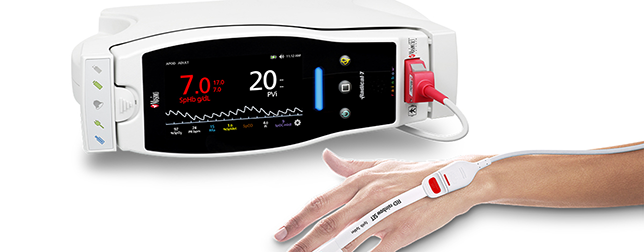Masimo has announced the findings of a recently published study in patients undergoing elective colorectal surgery. In the study, Dr. Sevim Cesur and colleagues from the Kocaeli University in Turkey used these patients to compare the performance of conventional fluid management (CFM) against goal-directed fluid management (GDFM) using Masimo PVi® (pleth variability index, measured noninvasively and continuously using SET® pulse oximetry sensors). Their main points of comparison were the amount of crystalloids administered and blood lactate and serum creatinine levels during the intraoperative period.
Noting the importance of intraoperative fluid management in terms of postoperative organ perfusion and complications, the researchers sought to compare the effects of CFM (guided by clinical assessment and heart rate, arterial blood pressure, and invasively measured central venous pressure) with GDFM (guided by clinical assessment and noninvasive Masimo PVi monitoring).
The study
The research team recruited 70 ASA I-II adults undergoing elective colorectal tumor surgery. They then divided the participants into two groups: CFM and GDFM. The researchers measured PVi using a Masimo Radical-7 Pulse CO-Oximeter with software version 7.0.3.3 and SET sensors.
In the CFM group, Dr. Cesur and his team administered Sodium chloride (NaCl) solution at the rate of 4-8 ml/kg/h. When mean arterial pressure (MAP) fell below 65 mmHg or 30% baseline MAP, they increased the infusion, initiated colloid, and administered ephedrine.
In the GDFM group, the researchers administered the same solution, but at a rate of 2 ml/kg/h. If PVi rose above 13% for more than 5 minutes, they first administered colloid and then ephedrine. The team continued treatments in both groups until values were restored to each protocol’s pre-treatment threshold.
Findings
The researchers found that intraoperative crystalloid administration, urine output, and end-surgery fluid balance were significantly lower in the GDFM (PVi) group.
The anesthesia and surgery duration, as well as the amounts of intraoperative bleeding and administered colloid, were similar in the two groups. The length of hospital stay was also found to be similar in the two groups.
Read more This “Smart Stent” Can Monitor Blood Flow and Detect Narrowing of Artery
Limitations
A limitation of the study, according to the researchers, were that they picked the number of participants based on their primary objective needs, which is the comparison of intraoperative fluid volume between the two protocols, therefore they may not have assessed enough participants to effectively compare secondary outcomes such as length of stay.
“We determined the primary goal of this study as the amount of intraoperative fluid volume and established 35 patients were needed for each group; if postoperative complications, the length of hospital stay [, were] determined as the primary goal, perhaps our numbers [in] each group [w]ould be different,” the authors wrote.













